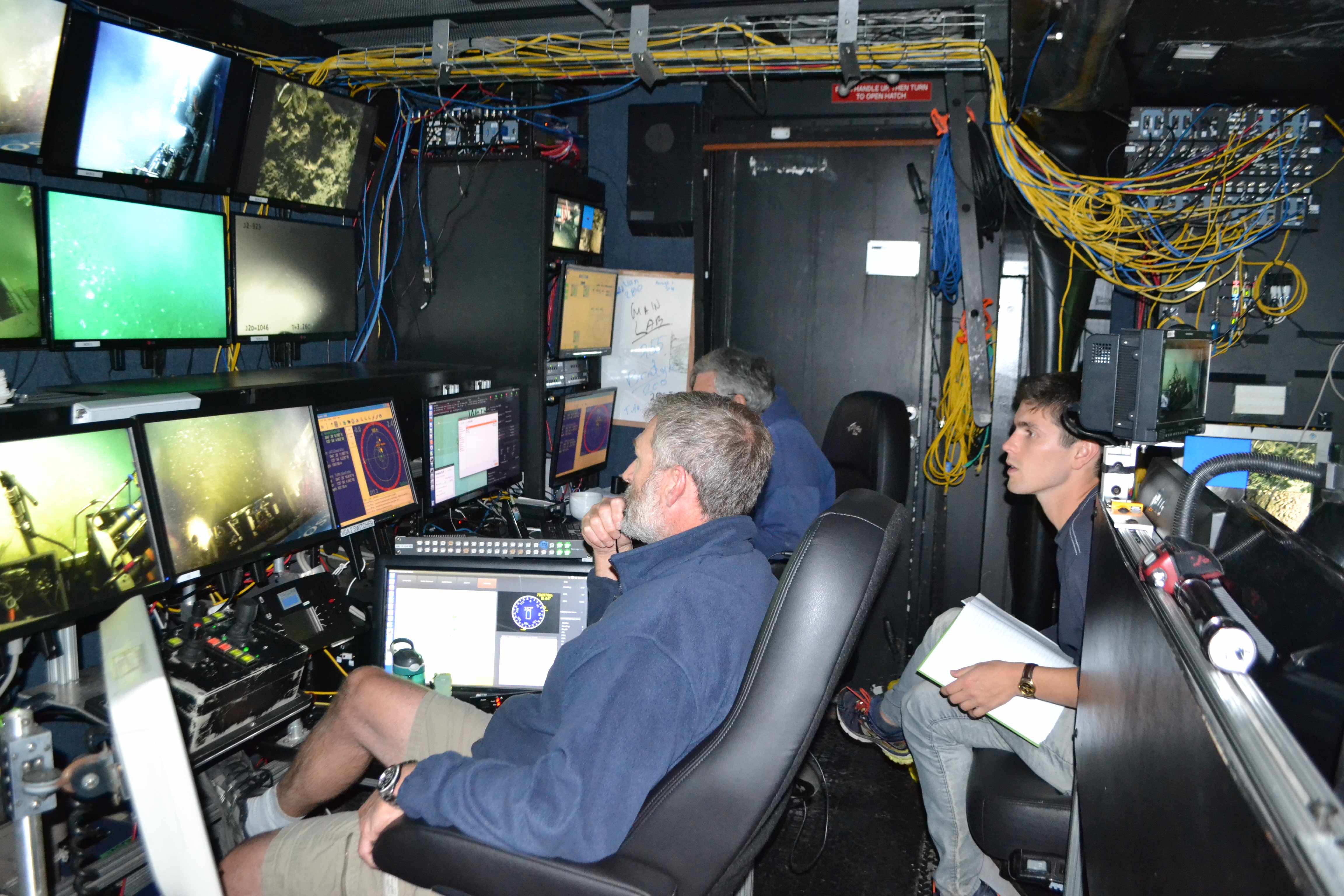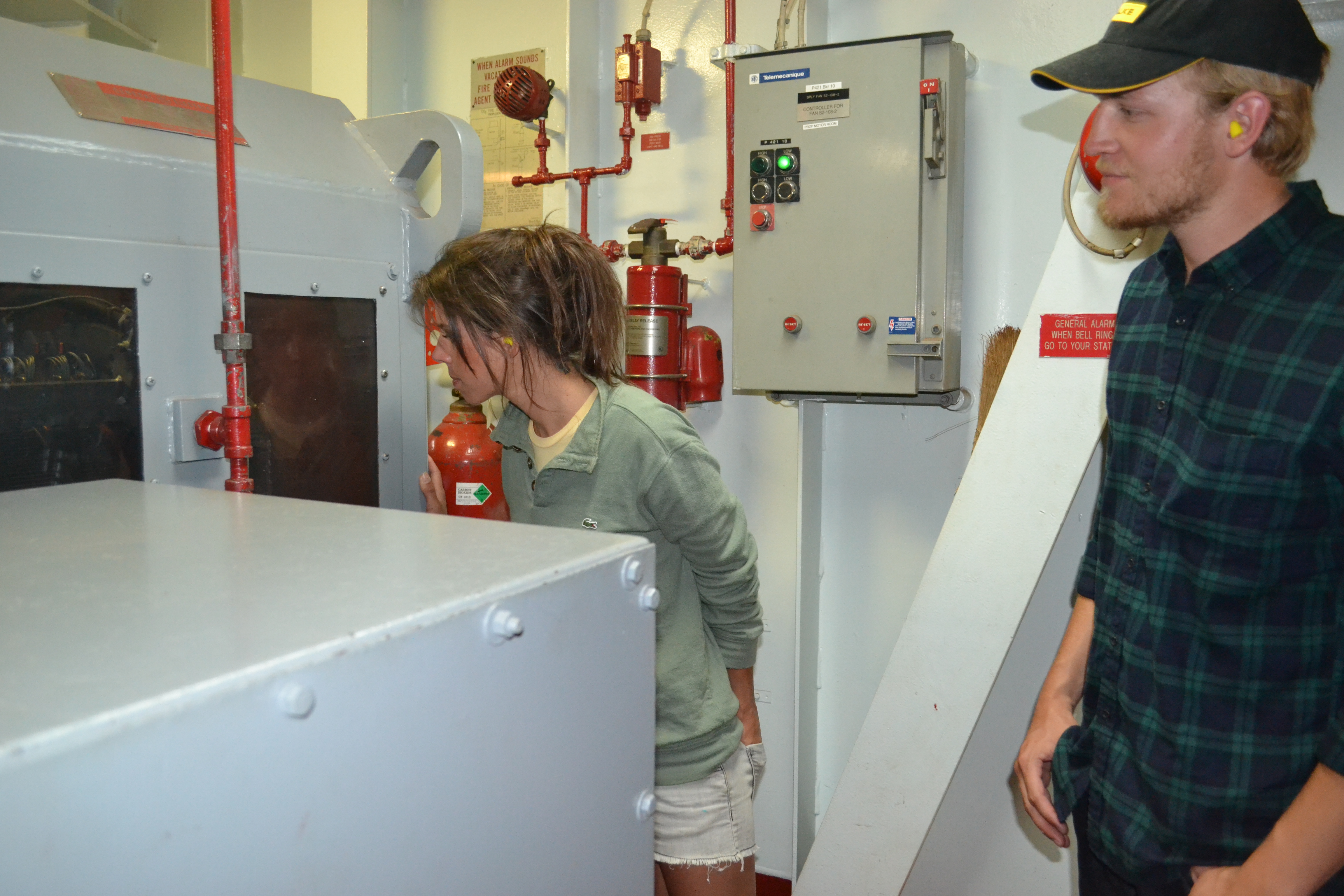Image Archive





























Chief Scientist, Orest Kawka, and Co-Chief Scientist, Brendan Philip, discuss cruise operations during Leg 2 of VISIONS'20. Credit: M. Elend, University of Washington.

Chief Scientist Brendan Philips oversees work on the fantail of the R/V Thompson as the ship prepares to sail again to complete Regional Cabled Array work for 2020. Credit. J. Tilley, University of Washington. V20

APL engineer, Trina Litchendorf, works on a digital still camera onboard the R/V Thompson during the VISIONS'20 expedition. Credit: University of Washington.

Eve Hudson dons her survival suit as part of the Leg 3, Day 1 safety briefing on R/V Atlantis. Credit: M. Elend, University of Washington, V19

APL enginner Trina Litchendorf pulls a fish from the winched Science Pod recovered 125 km offshore during Jason Dive 1045. Credit: K. Gonzalez, University of Washington, V18.

James Tilley, an engineer on the VISIONS'16 Cabled Array cruise, shoots off an XBT (expendable bathythermograph) that measures temperature through the water column. These data are put into mapping programs to insure that the sound velocity profile is accurate for a given location. Credit: M. Elend, University of Washington, V16.

Brendan Philip, a new graduate student at the School of Oceanography, University of Washington, leads an ROV Jason dive on a new seep site he discovered during the VISIONS'16 cruise. Credit: M. Elend, University of Washington, V16.

Erin watching the horizon with her camera ready. Credit: Malea Saul, UW; V15.

Students enjoying shoretime in Victoria, BC (CW from bottom left: Erin, Kearstin, Lauren, Emily, Malea). Credit: Erin Haphey, UW; V15.

Erica and Malea use a scraper to clean a recovered hydrophone frame and, maybe, sample some marine life. Credit: Mitch Elend, UW; V15.

R/V Thompson crewmember Sue is always willing to lend a hand on the deck. Credit: Mitch Elend, UW; V15.

Bob is still doing oxygens the old school way. Credit: Mitch Elend, UW; V15.

Malea has nominated Lauren for President and is already working on her campaign. Credit: Malea Saul, UW; V15.

Trina (APL-UW) does final preparation and checkout of a SAMI-pH sensor before the Platform Interface Controller is deployed. Credit: Mitch Elend (UW);V15.

Quae (Western Washington University) and Tracie (Grays Harbor College) peer into the rear thrusters’ electric motors during the engine tour. Credit: Jessica Noe, University of Washington; V15.

Chief Engineer Paul gives Leg 2 students of tour of the R/V Thompson's shop and engine room. Credit: Joe Kalisch, Grays Harbor College, V15.

Alex helps with the CTD onboard the R/V Thompson during Leg 2 of the VISIONS'15 cruise. Credit: Krista Nunnally, University of Washington, V15.

Tracie, enjoying the deck work aboard the R/V Thompson during Leg 2 of the VISIONS'15 cruise. Credit: Quae Atwood, Western Washington University; V15.

Quae Atwood, from Western Washington University, onboard the R/V Thompson during Leg 2 of the VISIONS'15 expedition. Credit: Tracie Barry, Grays Harbor College; V15.

Tracie intent on taking in the first fire and safety meeting onboard the R/V Thompson during Leg 2 of the VISIONS'15 expedition. Credit: Mitch Elend, University of Washington; V15.

Kearstin and Jessie are happy to be sailing on Leg 1 of the VISIONS'15. Credit: Mitch Elend, University of Washington.

University of Washington undergraduate, Jessie Hild, takes water samples for follow-on analyses from Niskin bottles onboard the R/V Thompson during the Cabled Array VISIONS'15 expedition. Credit: Mitch Elend, University of Washington.

Ben Brand shows Kearstin the 'ropes' in making multicolored monkey fists. Credit: Mitch Elend, University of Washington, V15.

Deb brings in a recovered carbonate cobble with egg casings of Neptunea snails from Southern Hydrate Ridge. The eggs can take up to 1 year to hatch. Credit: Mitch Elend, University of Washington, V15.

Malea and Diana laugh, recognizing they both dressed alike during a morning on the R/V Thompson expedition. Credit: Ed McNichol, V15.

Malea learns how to conduct oxygen analyses on seawater from >130 km offshore Newport Oregon. Credit: Deb Kelley, University of Washington, V15.

Jessica helps launch the CTD at the beginning of the Cabled Array VISIONS'15 expedition. Credit: Mitch Elend, University of Washington.

Kadijah learns how to do titration analyses of dissolved oxygen in fluids from up to 1000 m water depth on the VISIONS'15 cruise. Credit: Deb Kelley, University of Washington.
- Anemone
- Animal
- Arthropod
- ASHES
- Axial
- Axial Base
- Axial Biology
- Axial Caldera
- Bacteria
- Basalt Lava
- BEP
- Biofouling
- biolgoy
- Biology
- Camds
- Camera
- Camhd
- Central Caldera
- Ciliates
- Cnidaria
- Coastal Biology
- Crab
- Deep Profiler Mooring
- Dive Highlights
- Eastern Caldera
- Echinoderms
- Endurance Array
- Engineering Team
- ENLIGHTEN 10
- Exploratorium
- Fish
- Geology
- HD Camera
- HPIES
- Hydrate Ridge
- Hydrates
- Hydrophone
- Hydrothermal Vents
- Illustration
- Inshore 80 Meters
- Instrument
- International District
- J-BOX
- Jason
- Jellyfish
- Junction Box
- K12
- Lava
- Mollusk
- Moorings
- Nodes
- Nudibranch
- Octopus
- OOI
- Oregon Offshore
- Oregon Offshore 600 m
- Oregon Shelf
- Oregon Slope Base
- People
- PN1B
- PN1D
- Polychaetes
- PPSDN
- Primary Node
- RASFL
- ROCLS
- ROPOS
- ROPOS Dives
- ROV Team
- RV Revelle
- RV Sikuliaq
- RV Thompson
- Salp
- Sample
- SC13
- Science Team
- Sea Cucumber
- Sea Star
- Sea Urchin
- Seafloor
- Seismometer
- Sensors
- Shallow Profiler Mooring
- Shark
- Shipboard
- Shore Station
- Slope Base
- Smoker
- Soft Coral
- Southern Hydrate Ridge
- Sponge
- Squid
- Students
- Students & Guest Participants
- Tmpsf
- Tubeworms
- VISIONS 11 Leg 1
- VISIONS 11 Leg 2
- VISIONS 11 Viewers
- VISIONS 13
- VISIONS 14
- VISIONS 15
- VISIONS 16
- VISIONS 17
- VISIONS 18
- VISIONS 20
- VISIONS 22
- VISIONS 23
- Visualization
